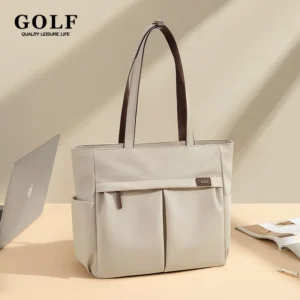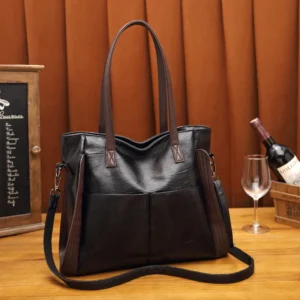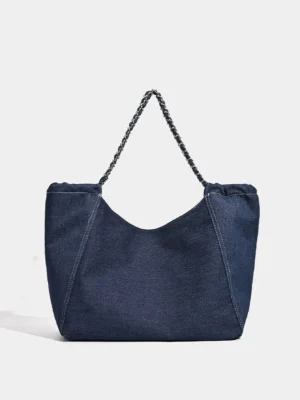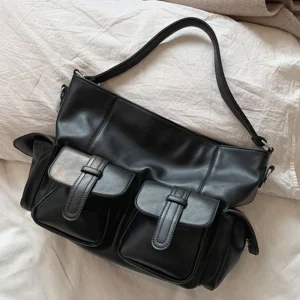Understanding Leather Work Bags and Their Care Requirements
Leather work bags represent more than just a carrying solution for your professional essentials—they’re an investment in your professional image and daily function. What separates leather work bags from other accessories is their unique combination of durability, sophistication, and the natural aging process that enhances their character over time.
Proper care isn’t optional with leather work bags—it’s essential. Without regular maintenance, even the highest quality leather can dry out, crack, or lose its luster. The good news? With appropriate care, a quality leather work bag can last decades rather than years, making it one of the most sustainable accessories in your professional wardrobe.
Before beginning any care routine, it’s crucial to identify what type of leather your bag features:
- Full-grain leather: The highest quality with visible natural markings, requires regular conditioning
- Top-grain leather: Slightly processed with a more uniform appearance, needs moderate care
- Patent leather: Features a glossy coating, requires specific cleaning products
- Suede/Nubuck: Has a soft, textured finish, demands specialized brushes and protectants
Each leather type has its own unique care requirements, making it essential to know your timeless classic leather briefcase material before starting any maintenance routine. The visual and tactile differences between these leathers—from the natural variations in full-grain to the uniform smoothness of top-grain—directly impact how you should approach cleaning, conditioning, and protection.
Understanding what makes your bag special is the first step in proper care. The quality indicators found in the best leather briefcases will help you determine the appropriate maintenance approach for your specific leather type.
Essential Leather Care Supplies: Building Your Maintenance Kit
Creating a comprehensive leather care kit ensures you’ll always have the right tools available to maintain your work bag’s condition. Think of this kit as an insurance policy for your investment—a small expense compared to replacing a premium leather bag.
Your essential leather care toolkit should include:
- Leather cleaner: Specifically formulated to remove dirt without stripping natural oils
- Leather conditioner: Replenishes moisture and prevents drying and cracking
- Microfiber cloths: Lint-free options for applying products and buffing
- Soft-bristled brush: For removing surface dust and reaching seams and corners
- Leather protectant: Creates a barrier against water, stains, and UV damage
- Small sponges: For targeted application of cleaners and conditioners
- Cotton swabs: Perfect for cleaning hardware and tight spaces
While these items form your must-have basics, more specialized tools like leather-safe spot treatment solutions and edge coating repairs might become useful as your bag ages. When selecting these products, quality matters significantly—inexpensive, harsh chemicals can do more harm than good.
Beware of household products that might seem convenient but can seriously damage leather:
- Household cleaners containing ammonia or bleach
- Alcohol-based products that dry out leather
- Furniture polish containing silicones that trap moisture
- Regular soap which can strip natural oils
Understanding the detailed aspects of leather tote care will help you determine how frequently to apply conditioners based on your specific leather type and usage patterns. Having the right supplies ready means you can address issues immediately, preventing minor problems from becoming permanent damage.
Establishing a Protective Care Routine: Daily and Weekly Habits
The most effective leather care happens before problems arise. Establishing consistent habits takes just minutes but saves hours of restoration work later. Think of leather maintenance like dental hygiene—regular small efforts prevent major interventions.
Daily Care (2-3 minutes)
- Empty completely at day’s end, allowing the bag to rest without strain from contents
- Gentle wipe down with a clean, dry microfiber cloth to remove surface dust and oils
- Check for spills or marks that might need immediate attention
- Proper placement on a clean surface, not the floor or damp areas
- Reshape gently if the bag appears to be losing its structure
Weekly Maintenance (5-10 minutes)
- Remove all contents and open all compartments
- Dust thoroughly with a soft brush, paying special attention to seams and hardware
- Check for scuffs or spots that need treatment
- Apply leather conditioner if needed (though full conditioning is typically less frequent)
- Inspect hardware for tarnish or looseness
Seasonal transitions require special attention, as temperature and humidity fluctuations can stress leather. Winter’s dry indoor heating and summer’s humidity both present unique challenges that may require adjusting your care schedule.
How you handle your bag daily dramatically impacts its longevity. Avoid grabbing it by straps with wet or dirty hands, overstuffing compartments, or setting it on rough surfaces. Learning how to properly maintain a leather briefcase can significantly extend your bag’s lifespan through these simple daily and weekly routines.
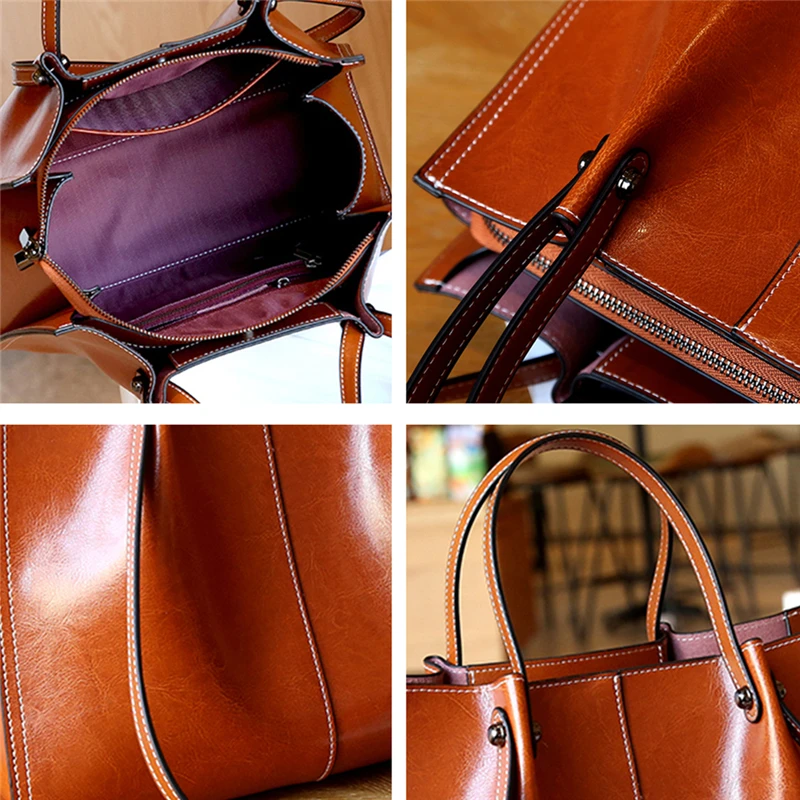
Deep Cleaning Your Leather Work Bag: Step-by-Step Process
Even with diligent daily care, your leather work bag will eventually require deep cleaning—particularly if it’s used daily in varied environments. Watch for these signs that indicate a thorough cleaning is necessary:
- Visible dirt buildup in creases and corners
- Dull appearance that doesn’t improve with simple dusting
- Sticky feeling on the surface
- Noticeable odor changes
- Uneven coloration or spots
When these signs appear, follow this comprehensive deep cleaning process:
Preparation (10 minutes)
* Empty all contents completely
* Remove any detachable straps or accessories
* Vacuum the interior using a low-power setting with upholstery attachment
* Stuff the bag with acid-free tissue to maintain shape during cleaningExterior Cleaning (15-20 minutes)
* Test your leather cleaner on an inconspicuous spot first
* Apply cleaner to a damp (not wet) cloth rather than directly on leather
* Work in small sections using gentle circular motions
* Pay extra attention to handles and areas that contact your body
* Allow to dry naturally away from direct heatInterior Cleaning (10-15 minutes)
* Vacuum thoroughly, reaching all corners
* For fabric linings, spot clean with appropriate fabric cleaner
* For leather linings, use the same leather cleaner as exterior but with lighter applicationHardware Cleaning (5-10 minutes)
* Clean metal components with a slightly damp cloth
* Use cotton swabs to reach crevices around hardware
* Dry immediately to prevent water spotsDrying (8-24 hours)
* Allow to air dry completely in a well-ventilated area
* Keep stuffed with tissue to maintain shape
* Never use hair dryers, heaters, or direct sunlight to speed drying
The key to effective cleaning is patience and gentleness. Rushing or scrubbing aggressively can damage the leather’s surface. For particularly stubborn marks or specialized situations, specific techniques for cleaning stains on leather bags may be necessary.
Conditioning and Moisturizing: Keeping Leather Supple
Conditioning leather is not unlike moisturizing skin—it maintains suppleness, prevents cracking, and preserves natural beauty. The science behind this is straightforward: leather, a natural material, contains oils that gradually evaporate with time and use. Conditioning replenishes these oils, preventing the protein fibers from drying and breaking.
Selecting the appropriate conditioner depends on your specific leather type:
- Full-grain leather: Benefits from natural oil-based conditioners (neatsfoot oil, mink oil)
- Top-grain leather: Responds well to cream-based conditioners
- Patent leather: Requires specialized patent-specific products
- Colored leather: Needs neutral conditioners that won’t alter dye
The proper conditioning technique is as important as the product itself:
- Start with a thoroughly clean, completely dry bag
- Apply a small amount of conditioner to a clean cloth (never directly onto leather)
- Work in thin layers using gentle circular motions
- Allow 15-20 minutes for absorption
- Buff away any excess with a clean cloth
- Allow 24 hours to fully absorb before using
Frequency recommendations vary by environment and usage. As a general guideline:
* Dry climates: Every 1-2 months
* Moderate climates: Every 3-4 months
* Humid climates: Every 4-6 months
Watch for warning signs to adjust this schedule. Underconditioned leather feels stiff and looks dull, while overconditioned leather appears darkened and feels greasy. The right balance leaves leather looking rich and feeling supple without residue.
Our collection of premium leather work totes are crafted to respond exceptionally well to proper conditioning, maintaining their elegance for years with appropriate care.
Addressing Common Stains and Damage: Practical Solutions
Even with meticulous care, accidents happen. The key to successful stain removal is prompt action and appropriate techniques based on the specific contaminant.
Immediate Spill Response Protocol
- Blot (never rub) liquid spills immediately with clean, absorbent cloth
- Remove solid materials with gentle scraping, not rubbing
- Allow area to dry naturally before assessing further treatment needs
- Treat specific stains based on their composition
Targeted Stain Solutions
Water Spots
* Allow to dry completely
* Gently buff with microfiber cloth
* For persistent spots, lightly dampen entire panel for even drying
Ink Stains
* Act immediately—ink becomes permanent quickly
* Blot (don’t rub) with dry cloth
* Apply leather-specific ink remover with cotton swab
* Work from outside in to prevent spreading
Oil and Grease
* Blot excess oil without pressing it deeper into leather
* Apply cornstarch or talcum powder to absorb oil
* Let sit overnight, then brush away
* Clean area with leather cleaner after absorption
Food Stains
* Remove solid particles immediately
* Blot moisture without spreading
* Clean with diluted leather cleaner
* Condition area after cleaning
Scuffs and Scratches
Minor surface scratches often respond well to:
1. Gentle buffing with clean fingers (natural oils help)
2. Light application of conditioner to affected area
3. Buff with soft cloth
For deeper scratches, leather-specific repair products matched to your bag’s color may be necessary, though significant damage might require professional intervention.

When selecting a work bag, many professionals appreciate the stylish functionality of women’s leather work totes that combine elegance with practical design while requiring similar care techniques.
Proper Storage Techniques: Preserving Shape and Condition
How you store your leather work bag when not in use significantly impacts its longevity and appearance. The ideal storage environment maintains leather’s natural properties without stressing its structure.
Optimal Storage Conditions
- Temperature: Cool to room temperature (60-75°F)
- Humidity: Moderate (40-60%)—neither too dry nor damp
- Light: Away from direct sunlight to prevent fading
- Air circulation: Moderate airflow prevents mildew
Short-Term Storage (Daily/Weekly)
- Empty bag completely
- Stuff lightly with acid-free tissue to maintain shape
- Stand upright on clean, flat surface
- Keep away from heat sources, direct sunlight, and damp areas
- Use a breathable dust bag if available
Long-Term Storage (Seasonal/Extended)
- Clean and condition thoroughly before storing
- Stuff firmly (not tightly) with acid-free tissue or air-filled bubble wrap
- Wrap hardware in tissue to prevent imprinting on leather
- Place in breathable cotton dust bag (never plastic)
- Store on shelf rather than hanging to prevent stretching
- Check periodically for moisture or pest issues
Common Storage Mistakes to Avoid
- Hanging by handles which distorts shape
- Stacking heavy items on top
- Storing in plastic which traps moisture
- Placing in attics or basements with temperature extremes
- Using newspaper for stuffing (ink can transfer)
Proper storage is particularly important for specialty items like laptop-compatible work totes that have structured compartments designed to protect electronics while maintaining the bag’s elegant profile.
Special Care for Hardware and Non-Leather Components
While leather often receives the most attention, hardware and non-leather elements require specific maintenance to ensure your work bag functions flawlessly throughout its lifetime.
Hardware Identification and Care
- Brass hardware: Develops patina naturally; clean with brass-specific products
- Stainless steel: Resistant to tarnish; clean with soft cloth and mild soap
- Nickel/silver-tone: May tarnish; use specialized metal cloths for polishing
- Gold-tone: Requires gentle cleaning to preserve finish; avoid abrasive cloths
For all metal components, avoid harsh chemicals and excessive moisture which can accelerate tarnishing or damage protective coatings.
Maintaining Moving Parts
- Zippers: Apply wax-based lubricant (never oil) to teeth periodically
- Clasps and locks: Clean dust from mechanisms with compressed air
- Hinges: Wipe clean and check for looseness regularly
The functionality of zippered leather work totes depends significantly on proper zipper maintenance, which prevents catching and ensures smooth operation throughout the bag’s lifetime.
Fabric and Interior Care
- Vacuum interiors regularly with low suction
- Spot clean fabric linings with appropriate fabric cleaners
- Allow to dry completely before closing bag
- Consider antimicrobial sprays designed for bag interiors if used in high-traffic environments
When cleaning hardware, always protect surrounding leather with tape or cloth barriers to prevent cleaner migration onto leather surfaces, which could cause staining or drying.
Brown Leather Work Tote, Large Leather Work Tote
$194.38 Select options This product has multiple variants. The options may be chosen on the product pageLeather Laptop Work Tote, Tan Leather Work Tote, Women's Leather Work Tote, Zippered Leather Work Tote
Price range: $223.62 through $237.97 Select options This product has multiple variants. The options may be chosen on the product pageBlack Leather Satchel, Brown Leather Satchel, Vegan Leather Work Tote
Price range: $69.58 through $73.23 Select options This product has multiple variants. The options may be chosen on the product pageCanvas & Leather Messenger Bag, Leather Commuter Tote
$80.41 Select options This product has multiple variants. The options may be chosen on the product pageBlack Leather Messenger Bag, Black Leather Work Tote, Faux Leather Work Tote
$101.88 Select options This product has multiple variants. The options may be chosen on the product pageBlack Leather Work Tote, Faux Leather Work Tote, Women's Leather Business Tote
Price range: $88.81 through $93.85 Select options This product has multiple variants. The options may be chosen on the product page
Seasonal Care Adjustments: Protecting from Environmental Factors
Each season presents unique challenges to leather integrity, requiring adjustments to your care routine to maintain optimal condition year-round.
Summer Protection
- Heat Concerns: Never leave leather bags in hot cars or direct sunlight
- UV Protection: Apply leather-specific UV protectant to prevent fading
- Humidity Issues: Use dehumidifiers in storage areas during humid months
- Handling: Touch bag with clean, dry hands as summer sweat contains salts that damage leather
Winter Safeguards
- Salt Protection: Apply water-resistant protector before winter weather
- Salt Removal: Immediately wipe away salt spots with damp cloth, then dry
- Indoor Dryness: Condition more frequently when heating systems are running
- Temperature Changes: Allow bag to acclimate to room temperature before cleaning if bringing in from cold
Spring/Fall Transition Care
- Perform deep cleaning at season changes
- Reassess conditioning needs as humidity fluctuates
- Check hardware and edges for winter damage
- Refresh protectant applications
Travel Considerations
- Pack leather care wipes for quick spot cleaning
- Store in breathable bags when in luggage
- Avoid packing liquid items with leather bags
- Allow bag to rest after travel before cleaning
Understanding how to protect your bag in various weather conditions complements knowledge about water-resistant leather bags and can prevent permanent damage from environmental exposure.
Professional Maintenance: When to Seek Expert Help
While regular maintenance can be handled at home, certain situations warrant professional intervention to preserve your investment and ensure proper restoration.
When to Consider Professional Services
- Deep, set-in stains that resist home treatment
- Structural damage to stitching or supports
- Color restoration or significant fading
- Hardware replacement or repair
- Torn linings or interior damage
- Mold or mildew contamination
- Strong odors that persist after cleaning
Finding the Right Specialist
- Leather goods repair shops specialize in bags and accessories
- Cobblers often handle leather repairs beyond just shoes
- High-end department stores sometimes offer repair services for premium brands
- Specialized leather restorers for vintage or exotic leathers
When evaluating potential services, ask about:
* Experience with your specific leather type
* Before/after examples of similar repairs
* Guarantee or warranty on work performed
* Timeframe for completion
* Products used in restoration process
Cost Considerations
Professional leather restoration typically ranges from $50-$200 depending on complexity, but this investment often proves worthwhile compared to replacement costs for premium bags. For bags with sentimental value or rare designs, professional restoration may be the only viable option to extend usability.

Can I Use Household Products to Clean My Leather Bag?
While specialized leather care products are always preferable, certain household items can serve as temporary solutions in emergencies.
Generally Safe Household Alternatives:
* Mild, fragrance-free facial soap (highly diluted)
* Distilled water for light cleaning
* White vinegar solution (highly diluted) for removing salt stains
* Baking soda for odor absorption (not directly on leather)
Products to Absolutely Avoid:
* Baby wipes (contain alcohol and chemicals)
* Household cleaners or disinfectants
* Furniture polish
* Olive oil or cooking oils (turn rancid)
* Hand sanitizer or alcohol-based products
In emergency situations, plain water on a barely damp cloth is safer than improvising with household chemicals. If you must use an alternative product, always test in an inconspicuous area first and follow with proper conditioning once specialized products are available.
Those interested in alternative materials might explore our vegan leather work totes which require different care approaches than traditional leather.
How Often Should Different Types of Leather Be Conditioned?
Conditioning frequency varies significantly based on leather type, usage patterns, and environmental factors. Use this guide while monitoring your bag’s specific needs:
| Leather Type | Normal Environment | Dry Environment | Humid Environment | Signs Conditioning is Needed |
|---|---|---|---|---|
| Full-grain | Every 3-4 months | Every 1-2 months | Every 4-6 months | Dull appearance, stiff feel |
| Top-grain | Every 4-6 months | Every 2-3 months | Every 6-8 months | Dry patches, light scratches not buffing out |
| Patent | Every 6-12 months | Every 4-6 months | Every 6-12 months | Loss of shine, stickiness |
| Suede/Nubuck | Every 6 months with specialized conditioner | Every 3-4 months | Not recommended in high humidity | Rough texture, water no longer beading |
Over-conditioning risks include darkening of leather, attracting dust, and clogging pores. Under-conditioning leads to drying, cracking, and permanent damage. Finding the right balance for your specific bag is crucial, as factors like quality construction in a perfect leather briefcase will affect how the leather responds to conditioning.
What’s the Best Way to Restore a Neglected Leather Work Bag?
Reviving a neglected leather bag requires patience and a systematic approach, but many seemingly hopeless cases can be substantially improved.
Assessment Phase
- Evaluate damage honestly—identify dryness, cracks, stains, hardware issues
- Test an inconspicuous area to see how leather responds to products
- Set realistic expectations—severe cracking or extensive color loss may improve but not completely resolve
Restoration Process
- Initial cleaning: Gentle, thorough cleaning with appropriate leather cleaners
- Deep conditioning: Multiple light applications over several days, allowing absorption between treatments
- Rest period: Allow 24-48 hours for leather to fully absorb conditioner
- Secondary conditioning: Focus on particularly dry areas
- Color restoration: Apply leather color restorer if needed for even appearance
- Hardware attention: Clean, polish, or consider replacement if severely damaged
- Protection: Apply leather protector once restored
Full restoration typically takes 1-2 weeks as leather gradually reabsorbs moisture and oils. The rehabilitation success largely depends on the original quality of the bag—premium items like those detailed in our guide to ideal leather briefcases often respond better to restoration efforts than lower-quality alternatives.
Is Waterproofing Necessary for Leather Work Bags?
Waterproofing represents one of the most misunderstood aspects of leather care, with important distinctions between true waterproofing and water resistance.
Water-Resistance vs. Waterproofing
* Water-resistance: Allows leather to repel light moisture temporarily
* Waterproofing: Creates a barrier that prevents any water absorption
Most leather professionals recommend water-resistant treatments rather than complete waterproofing because:
Benefits of Water-Resistant Treatments:
* Provides adequate protection for typical exposures
* Allows leather to maintain breathability
* Preserves natural characteristics and aging process
* Can be reapplied as needed
Potential Drawbacks of Full Waterproofing:
* May alter leather appearance and texture
* Prevents natural breathing, potentially trapping moisture inside
* Can interfere with patina development
* Often contains silicones that build up over time
For most professional environments, a quality water-resistant spray applied seasonally (particularly before rainy seasons) offers sufficient protection without compromising leather quality. Application should follow a cleaning and full drying period, with multiple light coats rather than one heavy application.
When selecting protective products, choose those specifically formulated for your leather type and always test on an inconspicuous area first to ensure it doesn’t change color or texture undesirably.



